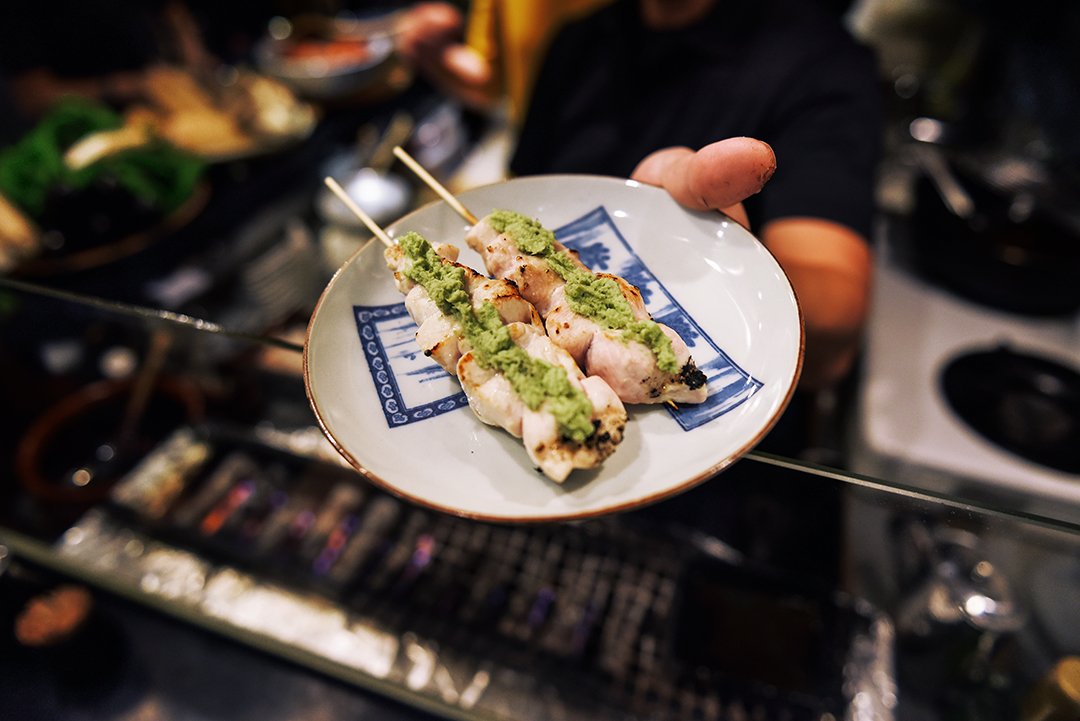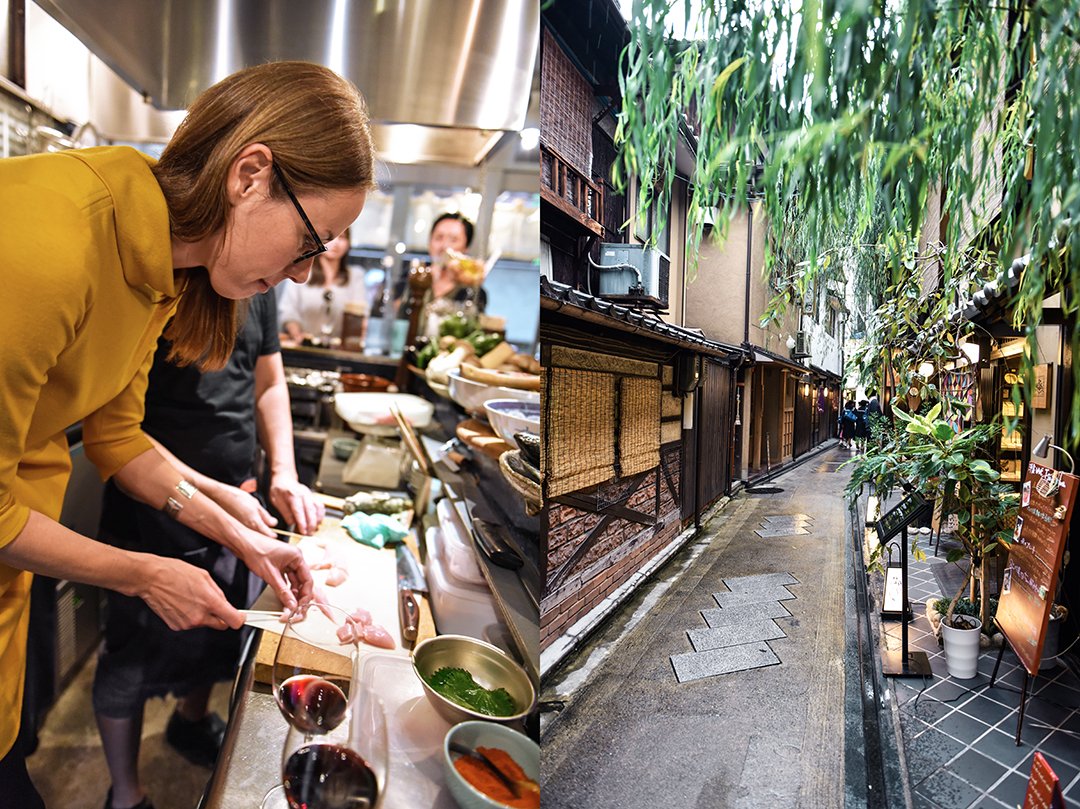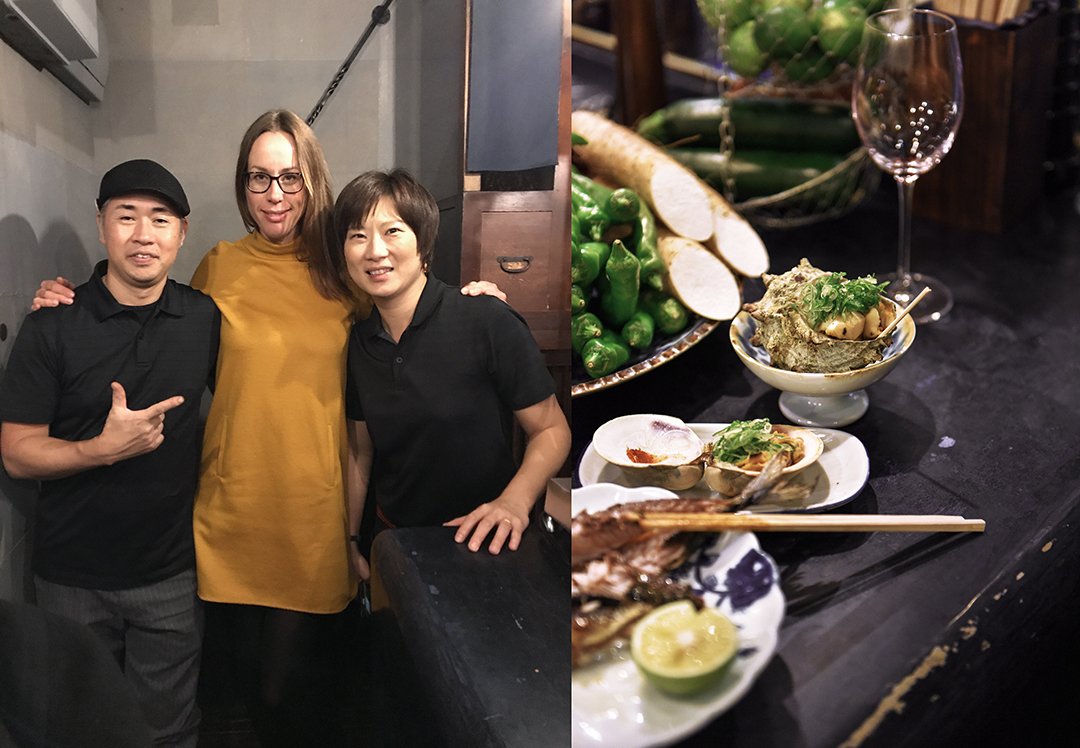Meet In Your Kitchen | Taka's Japanese-Italian Fusion Cuisine in Kyoto
Eating at Taka's restaurant in Kyoto feels like having a Japanese feast celebrated with your exuberant Italian family. The place is tiny, it's in a narrow old house tucked into a small secluded alley right in the old city's busy heart. An L-shaped counter separates the celebrated chef from his hungry guests, however, there's a lot of interaction going on. The kitchen is open so you can follow all of Chef Nishimura Takashi's steps, how he grinds the fresh wasabi in smooth circles on a shark skin-covered wooden board (the only proper way to grind the green root as I've learned). The charming chef looks like a versed dancer. He quickly grabs pots and spices from the shelves behind him and then, in the next second, turns around to briefly cook tender chicken sashimi (see the recipe below) in the flames of his little grill; or local beef, or mackerel until it has a crispy golden crust all around. The restaurant's menu is a revelation, sea urchin spinach and tempura lotus root sprinkled with matcha salt are simply divine. Sitting at the counter and enjoying Japanese tapas is a feast in its true meaning: You eat, drink, and share delicious treats with old and new friends.
Kyoto born Chef Taka has lived and worked abroad for years, in Australia, Denmark, and in Italy, in Milan, where he also met his wife Akane. Before they opened their gastro pub in Kyoto, Taka worked at Armani's Nobu Milano restaurant for 10 years, which explains why you can also find wonderful organic Tuscan wines and Mediterranean style dishes on the menu, like the fruitiest eggplant slowly cooked in an aromatic tomato sauce. It's the combination of these two worlds that makes the couple's restaurant in Kyoto so exciting, yet at the same time it's so relaxed. It's the kind of place where you end up chatting with the guests sitting next to you, exchanging stories and dishes, saying Kanpai (cheers) with a glass of red wine in your hand or ending the night with an extensive sake tasting involving everyone in the room.
Taka and Akane love food and people, the people who visit them, their guests, and the people they work with, their kitchen team, but also the suppliers who deliver fresh produce and products of the best quality to this tiny kitchen in the heart of Kyoto. The couple knows all of them personally, they've been working with them for years, most of them coming from the area. Having lived and worked in two food meccas in the world, Italy and Japan, the restaurateurs say that they can only create fantastic food, if the ingredients are perfect, vegetables picked at the peak of their season, the meat coming from animals that were bred and fed with care and respect. Japanese and Italian cooking is similar, both cuisines are very simple and focus on good ingredients, and at Taka, they create a very complete fusion.
In the next months, I’ll share many Meet In Your Kitchen features with you that took me to California, Italy, France, and Japan. Thanks to Zwilling for sponsoring these features for our culinary trip around the world!
Grilled Chicken Sashimi with Wasabi
By Taka Nishimura
Chef Taka uses chicken of outstanding quality, he knows the farmer and he can guarantee the meat's quality and freshness, which is why he can serve this dish almost raw. However, it is highly recommended to cook chicken until it's cooked through.
Serves 2
4 skinless, boneless chicken breast tenderloins, sashimi grade
Freshly grated wasabi
Rock salt
4 wooden skewers
Heat the BBQ.
Cut each chicken tenderloin into 6 pieces and thread onto the 4 skewers. Grill lightly until just done.
Spread the chicken with freshly grated (!) wasabi and season with salt to taste. Serve immediately.
Could you introduce yourself?
My name is Nishimura Takashi. I lived in Italy for a long time, about 15 years. I worked in a world-renowned restaurant called NOBU. And about 2 years ago I moved back to Kyoto, my hometown, to open this small restaurant.
What is your most cherished childhood memory connected to the kitchen?
A cherished memory would have to be, when I was a child, all I watched were shows about food on TV. All I watched were cooking TV shows, and I remember cooking a lot with my siblings when we were small. No one in my family is a cook, I'm the only one who followed a career as a chef. And it was when I was in primary school that I decided to become a chef, it was then that I decided to learn how to cook Japanese cuisine.
Why did you decide to move to Italy and work in Italy as a chef?
Well, I had always made Kaiseki cuisine in Kyoto, I trained in Kyoto Kaiseki for about 15 years. And so then, at that time, Kyoto was amazing, it was a narrow entrance into Japanese cuisine. Now foreigners come here to learn how to cook Kaiseki, but it wasn't like that at all back then. So I wondered why? Japanese people go to Italy to study Italian cuisine, and to France to study French cuisine. So I thought, why don't foreigners come to Japan to study Japanese cuisine? I figured that if that was the case than I wanted to go abroad to teach Japanese cuisine, that's what I felt I wanted to do. And I remember feeling that I'd been a chef for 10 years, I'd learnt a lot in that time and wanted to share my knowledge abroad. So I chose somewhere that had similar food. I first chose Italy because I thought they had a simple way of cooking, and ingredients that had a lot of umami, where Japanese cuisine would be accepted by Italian tastes. And then I worked at NOBU in Italy.Now, in the last 10 years, things changed. Many chefs come to Kyoto and Osaka, Tokyo, studying the Japanese style.
What changed over the years?
That was probably because Japanese chefs became more open-minded. I think one reason is that they began to look outside Japan more. Also, famous chefs wanted to learn more about the mentality behind Japanese Kaiseki cuisine and how to make it. Making each course and slowly serving one small plate after another is Japanese Kaiseki's style. That's how you draw people to your restaurant. You're delicate even when you serve the food, there is even a special orientation for each plate.Every country's cuisine is wonderful, but in Japan it's all about the cut. For example, how sashimi is cut, how the vegetables are cut, how the meat is cut. These cuts create an excellent style of cooking, it's Japanese cooking. It's "katsuru" which means "cuts", which is what gives it such a high aesthetic. Even with sashimi the chefs cut them beautifully. It creates a very unique Japanese aesthetic. The kitchen knife cuts amazingly, every day you need to sharpen your knives, and sharpening them is one part of a chef's training, and I think even foreigners now sense this beauty. That's what I think. Vegetables cut straight, how they're beautifully peeled into hexagons, all kinds of shapes, the manual work that goes into it is amazing.
What makes a good knife? What are the important features of a good knife?
Of course how it cuts, the better it cuts the more beautiful the cut is. Also, how it feels when you hold it. You might have the same knife, but their weights can be different. Or there are knives that suit only you, so Japanese chefs will always buy their own knives. There's also a balance to them. And chefs are using them for a long time, for the entire day, so it needs to not get worn out, it needs to not be a burden for chefs that work for a long time. I think all of these things are considered when knives are made, there's a long history for this. Japanese knives are very particular. Fish is fish, vegetables are vegetables, meat is meat, and we divide them as such, but I think a knife that can be used for all of these is amazing.
What is special about Kyoto cuisine compared to other parts of this country?
I'd say how we compose the meal. There are a lot of difficult things about it but the best thing is how you can enjoy it as you like. Next is how the plates match. There are a number of Japanese meals where you look at the plates as you eat, and there are lots of regions that can make great plates. There's also the matter of gathering good ingredients. Of course each region of Japan has its own wonderful ingredients, but among those, you have Kyoto chefs who will search all over the place to find the best ingredients of the season and who will think of their customers’ faces as they make them. That mentality is unbroken, it's passed down from generation to generation, there's always been this fantastic culture. That's why there are so many things that I think are amazing.In Kyoto, it's really easy to distinguish between the 4 seasons. So when autumn comes you can use autumn ingredients and incorporate their beauty into the food. Kyoto chefs understand this sensibility.
How close is the relationship between you and your suppliers?
That's a great question. You can do that really easily in Kyoto. I've been working… since I was young, so I've been working with suppliers since the beginning. There are fishmongers and vegetable suppliers that I've known for over 30 years. People also introduce me to people they know, like butchers. I've used a lot of connections, and I try to use Kyoto wholesalers as much as possible, and I want to use them more. I have my restaurant in Kyoto right now. We say "local produce for local consumption", and it was the same in Italy. There are ingredients specific to regions and I try to incorporate them in my cooking as much as possible. Now I get requests from the Ministry of Agriculture and other chefs help out too. I want to help revitalise the area, so I get introduced to a lot of different people, and I can get hold of good ingredients. That really makes this job easier.
What was your vision for your restaurant?
I wanted a small restaurant where I could be close to customers sitting at the counter, so they're closer to the chef too. That way everyone can enjoy themselves as they eat, that makes the meal even more delicious. That way people's circle of friends could grow too. I want to make a restaurant like that and introduce everyone to it. And if I get any foreign customers, I want to help give them a place where they can make wonderful memories of Kyoto. I really wish from the bottom of my heart that I can help them make memories.
Thank you, Taka and Akane, for creating wonderful food and memories!











